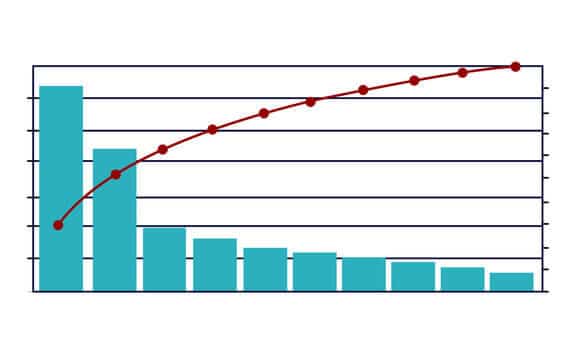Root cause analysis tools are used to support quality management.
They identify and solve problems by allowing you to see the root causes of issues that you’re dealing with.
With good root cause analysis tools, you’re able to dig down and see why your operations are running the way they are.
You’ll see common defects and errors, so you can make the changes that are necessary to help your business grow successfully.
Which of these tools is right for you? There are dozens on the market today, but we’ve put together a list of the best.
With these, you can get to the bottom of issues and find core problems, so you can resolve them and move forward. Check them out!
- 1. Pareto Charts
- 2. Failure Mode and Effect Analysis (FMEA)
- 3. 5 Whys
- 4. Ishikawa Fishbone Diagram
- 5. Fault Tree Analysis
- 6. 8D Report Template Checklist
- 7. DMAIC Template
- 8. Scatter Diagram
1. Pareto Charts
Pareto charts are the first root cause analysis tool to consider if you’re looking for one that will show you what you need to know graphically.
Pareto charts are bar graphs in most cases, and they show the ordered frequency of counts of data. This means that the charts can be used to show which areas need your attention first for improvement purposes.
Looking at the Pareto chart, the length of the bars stands for the cost or frequency (money or time). The longest bars usually are arranged at the left and go down as you move forward across the graph.
So, by looking at this chart, you can immediately see what needs your attention first and balance where you spend your time and money.

2. Failure Mode and Effect Analysis (FMEA)
The Failure Mode and Effect Analysis, or FMEA, focuses on failures that happen within a particular system. You can use this during several phases of a project, such as:
- Designing
- Implementation
- Planning
- Inspection
The two parts include Failure Mode as well as Effect Analysis.
With Failure Mode, what you’re looking at is identifying the ways in which something can fail. With the Effect Analysis, you’re looking at the effects of the failure modes.
For example, an automated teller machine (ATM) needs to dispense cash when a customer requests it. A failure could be dispensing too much money or failing to dispense anything.
In the Effect Analysis, you’d look at both Failure Modes to determine the possible effects.
For a machine dispensing too much money, the bank, in this case, could lose too much money or have errors in accounting later on.
For machines that don’t pay out enough, customers could become dissatisfied and leave the bank. There may also be accounting errors on the backend.
3. 5 Whys
The 5 Whys is an investigative method. This method helps you get down to the bottom of a problem by fully investigating it. You just have to keep asking, “why?”
This tool is great for exploring and investigating problems that don’t require quantitative analysis. You can also combine this tool with others, like the Pareto chart, to really dig into an area that needs more attention.
Here’s an example. You may have a product with a defect. You should ask several “why” questions to figure out the cause. For example:
- The product has a crack in the outer plastic. Why?
- There is too much pressure on the plastic during manufacturing. Why?
- The press needs to be firm to press down on the piece. Why?
- The pieces need to interlock correctly.
Asking these questions, you can eventually get to a point where you see a possible way to resolve a problem.
For instance, in the example above, you might address interlocking the pieces in another way to prevent cracking.
4. Ishikawa Fishbone Diagram
In school, you may have used a fishbone diagram to break down problems into subcategories.
This diagram looks at a big problem and figures out all the possible causes. Then, it breaks them down into subcategories that link back to the main issue being investigated.
For instance, you might say, “the plastic on this product is cracked.” Each part of the fishbone diagram would break down the potential causes into categories like:
- Material
- Method
- Machine
- Measurement/Medium
- Man/Mind Power
Then, potential causes would be investigated within those categories until a resolution could be found.
A fishbone diagram is used when there is no known root cause and major brainstorming has to take place.
5. Fault Tree Analysis
Fault tree analysis is another kind of graph you can build to investigate how a top fault (also known as an abnormal condition or failure) happened.
For instance, if a toxin leeched out of a container, you would want to start looking at the possible causes and solutions to prevent issues from arising again in the future.
Fault tree analysis is broken down into parts including four major steps:
- Scoping to define the event and determine the scope.
- Developing the tree with relevant causes and items.
- Validating the tree with qualitative or quantitative information, supply chain information or other data.
- Verifying the information with qualitative or quantitative data.
Overall, fault tree analysis is used to promote reliability, maintainability, and safety analyses.
6. 8D Report Template Checklist
The 8D report template checklist is a comprehensive list that documents root-cause analysis using the eight disciplines of problem-solving.
The 8D method uses eight steps to deal with issues that come up. The following steps are used, in order, to come up with a resolution.
- Establish a team. Create a team to deal with issues that happen and find solutions to problems
- Define what the problem is. A team needs to define the problem before trying to solve it.
- Contain any problems that arise. The team should focus on containing the problem without affecting daily business operations. The goal is to minimize the impact of a problem and avoid a chain reaction.
- Find the root cause. Look at the specific problem and use root cause analysis to funnel down to find a solution.
- Define the appropriate corrective measures. Corrective steps are taken at this stage.
- Track all progress. Now, track all progress as the corrective actions are taken.
- Establish preventative measures for the future. Doing this prevents recurrence.
- Recognize the team. Finally, using this method, recognize the team’s hard work and ability to overcome a problem with innovative solutions.
Ideally, an 8D report is finalized within eight days. This isn’t always possible, but it can be a goal for companies attempting to use it.
7. DMAIC Template
A DMAIC template gives you a structured approach to solving problems that you come across. Each letter stands for something different.
D- Define
Define is the first step and first factor in DMAIC. During this stage, teams look at a specific problem or goal and define it.
The purpose of this stage is to set the focus and context of an issue, so the team may focus on it.
M- Measure
Measure is the next step. The point of this step is to use metrics to track or measure a problem.
It’s normal to use Pareto charges, for example, to identify which areas need attention on a project and to see how progress is being made over time.
A- Analyze
Analyzing is the next step. Using root cause analysis, you can break down the potential causes of problems that you’re dealing with.
By doing this, you can help prevent the issue from occurring again in the future.
Sometimes, the root causes are unknown. In those cases, it’s important to list them out and prioritize them, so you can tackle each one.
I- Improve
Improving is the next step. At this stage, you look at performance improvements that could be used to eliminate some of the root causes that could be causing issues.
During this stage, all improvements should lead to positive changes. If they do not, they should be rolled back, and new improvements should be tried.
C- Control
Control is the final step. During this stage, the goal is to ensure continued quality. It’s important that all improvements are sustainable and that adjustments can be made when they’re needed (if they’re needed) in the future.
DMAIC is one of several helpful problem-solving methods that you may want to use. It’s good for building measurable success and accountability in a workplace.
8. Scatter Diagram
A scatter diagram is another kind of root cause analysis tool. It’s also known as a scatter plot.
With this kind of diagram, the relationship between two sets of data can be explored.
Plot an independent variable on the X-axis and the dependent variable on the Y-axis. When there is a direct curve or line between the two plotted points, there is a correlation between them.
You may also be interested in these articles:
- SEO Project Management for Beginners: This is What you Need to Know
- How to get stakeholder approval in projects
- 5 steps to define the scope of a project
Any one of these helpful root cause analysis tools could help you determine the causes of problems in your work and resolve them, so you can move forward with your business successfully.
If you’re interested in keeping boosting your business, you may also consider investing in content.
WriterAccess is the perfect platform to help you streamline your content production, combining the efficiency of AI with the creativity of human writers.
Why not give WriterAccess a try today? Sign up now and get 14 days of free access to our network of expert writers. Discover for yourself what great content can do for your business!







